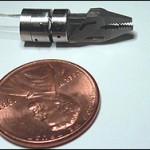Nautilus: Team’s tiny robot called medical science ‘breakthrough’
A miniscule robotic surgical tool created by engineers and surgeons at Vanderbilt University and Columbia University is singled out by Nautilus science magazine with four other remarkable developments as “unlikely breakthroughs” in medical science with potentially widespread applications.
The Nautilus article is part of a monthly package of articles on a single topic. Each Thursday Nautilus publishes a new chapter on a topic online. Issue 004’s topic is “The Unlikely.”
Under “Lilliputian Surgeons,” the article describes an image guided in-vivo surgical tool developed by Nabil Simaan at Vanderbilt and Peter Allen and Dennis Fowler at Columbia.

The Insertable Robotic Effector Platform (IREP)
The Insertable Robotic Effector Platform (IREP) can enter the body through a single 15 millimeter incision, unfold from its capsule and, following a surgeon’s instructions, move toward a particular organ to execute surgical tasks, such as clamping arteries and tying sutures, author Lina Zeldovich reports.

IREP wrist gripper
“To test it, surgeon Dennis Fowler performed a number of appendectomies, nephroscopies, and other operations on porcine models. Then, mechanical engineer Nabil Simaan at Vanderbilt University equipped IREP with two snake-like arms built from a series of vertebrae strung together with wires, which can bend and twist the arms in the required directions. Simaan also gave IREP wrists and grippers to manipulate objects.
To read further: Nautilus: Team’s tiny robot called medical science ‘breakthrough’
